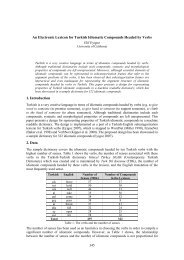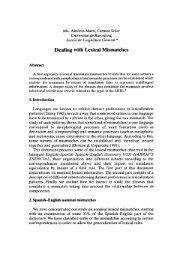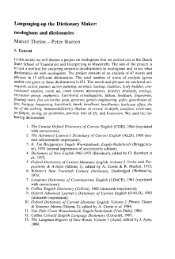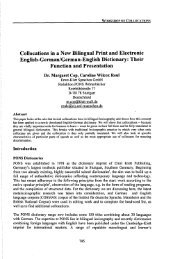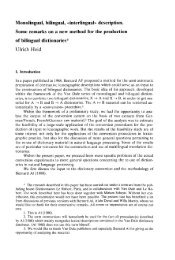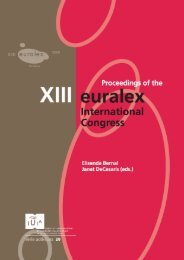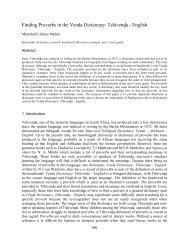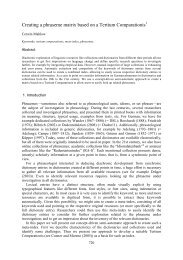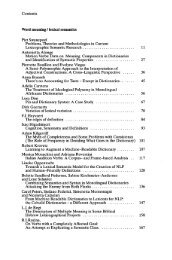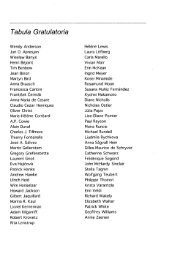Mary Snell-Hornby THE BILINGUAL DICTIONARY - HELP ... - Euralex
Mary Snell-Hornby THE BILINGUAL DICTIONARY - HELP ... - Euralex
Mary Snell-Hornby THE BILINGUAL DICTIONARY - HELP ... - Euralex
Create successful ePaper yourself
Turn your PDF publications into a flip-book with our unique Google optimized e-Paper software.
In contrast to that, I would like to point out that in the<br />
training of professional translators the general bilingual dictionary<br />
is rather discouraged, and in my experience onlymonolingual<br />
dictionaries are permitted for use in examinations. This would<br />
indicate that the glib labelling of the general bilingual dictionary<br />
as the "translator's dictionary' is erroneous. Indeed, bilingual<br />
lexicography requires a good deal of differentiation,<br />
as regards its varied purposes and types of user, and according<br />
to its lexical content. For tourists, for example, the small pocket<br />
dictionary will remain indispensable; for technical terminology<br />
and standardized concepts ,the bilingual dictionary seems the<br />
optimal solution; for the language learner, up to a certain level<br />
of competence, specially adapted bilingual dictionaries would<br />
be invaluable.<br />
In this paper 1 would like to concentrate on an area which<br />
I have discovered by experience and confirmed by empirical research<br />
to be unsatisfactorily treated in the general bilingual<br />
dictionary. This is especially the case with those lexemes in<br />
everyday language that reflect the perception and evaluation of<br />
the speaker and involve culture-specific factors or relationships<br />
to personal or socially set norms. Such lexemes are usually distorted<br />
by approximate renderings in the form of rough equivalents<br />
and require a high degree of 'delicacy' (cf. Halllday 1976:72)<br />
in their analysis. Our envisaged user is therefore the translator,<br />
the foreign language teacher, or the advanced student at university<br />
level.<br />
The descriptive verb<br />
As a prototype of this problematic area of vocabulary, I would<br />
like to take a type of verb immediately recognizable to the experienced<br />
translator as a chronic source of difficulty, which I have<br />
identified as the 'descriptive verb' (<strong>Snell</strong>-<strong>Hornby</strong> 1983). Typical<br />
examples in English are bustle, nag, prowl and gleam, and in<br />
German huschen, keifen and scheppern. The descriptive verb centres<br />
particularly ôn fields of human Behaviour and activity, as well<br />
as on verbs expressing perception, mainly of sound, light, movement<br />
and speed. In semantic terms, it can be broadly defined as<br />
a structure focussing not on the verbal action itself, but on<br />
a complex of modifying elements describing the manner in which<br />
the action is carried out, evaluated or perceived, whereby one<br />
of the participants in the action is characterized by the speaker.<br />
This complex of elements expressing characterization or mode of<br />
perception is realized in the verb's basic definition by 'dynamic<br />
adjectives' which are, firstly, susceptible to subjective measure<br />
and secondly, gradable, expressing relative value that can be<br />
judged in terms of an implied and accepted norm (cf. Quirk et<br />
al. 1972:265). As examples let us take English bustle, characterizing<br />
human activity, and German huschen, expressfhg perception<br />
of movement. (My source texts are literary works by Boll, Durrell,<br />
Frisch, Heym, Isherwood, Masters and O'Brien.) In bustle, the type<br />
of verbal action is left open, as in the following example:<br />
(la) He recalled an aimless bustling in the night, but now<br />
all was in order.<br />
This must where necessary be specified by the context:



